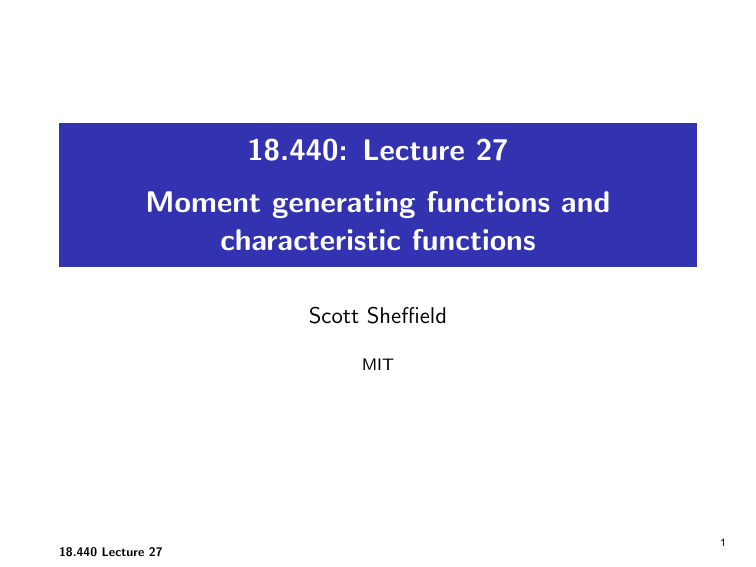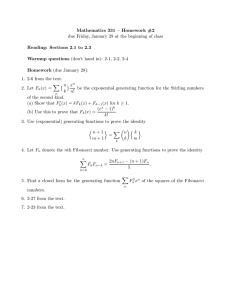18.440: Lecture 27 Moment generating functions and characteristic functions Scott Sheffield
advertisement

18.440: Lecture 27
Moment generating functions and
characteristic functions
Scott Sheffield
MIT
18.440 Lecture 27
1
Outline
Moment generating functions
Characteristic functions
Continuity theorems and perspective
18.440 Lecture 27
2
Outline
Moment generating functions
Characteristic functions
Continuity theorems and perspective
18.440 Lecture 27
3
Moment generating functions
I
I
I
I
I
I
I
Let X be a random variable.
The moment generating function of X is defined by
M(t) = MX (t) := E [e tX ].
P
When X is discrete, can write M(t) = x e tx pX (x). So M(t)
is a weighted average of countably many exponential
functions.
R∞
When X is continuous, can write M(t) = −∞ e tx f (x)dx. So
M(t) is a weighted average of a continuum of exponential
functions.
We always have M(0) = 1.
If b > 0 and t > 0 then
E [e tX ] ≥ E [e t min{X ,b} ] ≥ P{X ≥ b}e tb .
If X takes both positive and negative values with positive
probability then M(t) grows at least exponentially fast in |t|
as |t| → ∞.
18.440 Lecture 27
4
Moment generating functions actually generate moments
I
Let X be a random variable and M(t) = E [e tX ].
d tX d
Then M 0 (t) = dt
E [e tX ] = E dt
(e ) = E [Xe tX ].
I
in particular, M 0 (0) = E [X ].
I
Also M 00 (t) =
= E [X 2 e tX ].
I
So M 00 (0) =
of M at zero is E [X n ].
gives that nth derivative
I
Interesting: knowing all of the derivatives of M at a single
point tells you the moments E [X k ] for all integer k ≥ 0.
I
Another way to think of this: write
3 3
2 2
e tX = 1 + tX + t 2!X + t 3!X + . . ..
I
Taking expectations gives
2
3
E [e tX ] = 1 + tm1 + t 2!m2 + t 3!m3 + . . ., where mk is the kth
moment. The kth derivative at zero is mk .
I
d
d
0
tX
dt M (t) = dt E [Xe ]
E [X 2 ]. Same argument
18.440 Lecture 27
5
Moment generating functions for independent sums
I
Let X and Y be independent random variables and
Z = X +Y.
I
Write the moment generating functions as MX (t) = E [e tX ]
and MY (t) = E [e tY ] and MZ (t) = E [e tZ ].
I
If you knew MX and MY , could you compute MZ ?
I
By independence, MZ (t) = E [e t(X +Y ) ] = E [e tX e tY ] =
E [e tX ]E [e tY ] = MX (t)MY (t) for all t.
I
In other words, adding independent random variables
corresponds to multiplying moment generating functions.
6
18.440 Lecture 27
Moment generating functions for sums of i.i.d. random
variables
I
We showed that if Z = X + Y and X and Y are independent,
then MZ (t) = MX (t)MY (t)
I
If X1 . . . Xn are i.i.d. copies of X and Z = X1 + . . . + Xn then
what is MZ ?
I
Answer: MXn . Follows by repeatedly applying formula above.
I
This a big reason for studying moment generating functions.
It helps us understand what happens when we sum up a lot of
independent copies of the same random variable.
18.440 Lecture 27
7
Other observations
I
If Z = aX then can I use MX to determine MZ ?
I
Answer: Yes. MZ (t) = E [e tZ ] = E [e taX ] = MX (at).
I
If Z = X + b then can I use MX to determine MZ ?
I
Answer: Yes. MZ (t) = E [e tZ ] = E [e tX +bt ] = e bt MX (t).
I
Latter answer is the special case of MZ (t) = MX (t)MY (t)
where Y is the constant random variable b.
18.440 Lecture 27
8
Examples
I
Let’s try some examples. What is MX (t) = E [e tX ] when X is
binomial with parameters (p, n)? Hint: try the n = 1 case
first.
I
Answer: if n = 1 then MX (t) = E [e tX ] = pe t + (1 − p)e 0 . In
general MX (t) = (pe t + 1 − p)n .
I
What if X is Poisson with parameter λ > 0?
P
e tn e −λ λn
Answer: MX (t) = E [e tx ] = ∞
=
n=0
n!
P∞ (λe t )n
t
−λ
−
λ
λe
t
e
=e e
= exp[λ(e − 1)].
n=0 n!
I
I
We know that if you add independent Poisson random
variables with parameters λ1 and λ2 you get a Poisson
random variable of parameter λ1 + λ2 . How is this fact
manifested in the moment generating function?
18.440 Lecture 27
9
More examples: normal random variables
I
What if X is normal with mean zero, variance one?
R∞
2
MX (t) = √12π −∞ e tx e −x /2 dx =
R∞
2
2
2
√1
+ t2 }dx = e t /2 .
exp{− (x−t)
2
2π −∞
I
What does that tell us about sums of i.i.d. copies of X ?
I
If Z is sum of n i.i.d. copies of X then MZ (t) = e nt
I
What is MZ if Z is normal with mean µ and variance σ 2 ?
I
Answer: Z has same law as σX + µ, so
2 2
MZ (t) = M(σt)e µt = exp{ σ 2t + µt}.
I
18.440 Lecture 27
2 /2
.
10
More examples: exponential random variables
I
I
What if X is exponential with parameter λ > 0?
R∞
R∞
MX (t) = 0 e tx λe −λx dx = λ 0 e −(λ−t)x dx =
λ
λ−t .
I
What if Z is a Γ distribution with parameters λ > 0 and
n > 0?
I
Then Z has the law of a sum of n independent copies of X .
λ n
So MZ (t) = MX (t)n = λ−
t .
I
Exponential calculation above works for t < λ. What happens
when t > λ? Or as t approaches λ from below?
R∞
R∞
MX (t) = 0 e tx λe −λx dx = λ 0 e −(λ−t)x dx = ∞ if t ≥ λ.
I
18.440 Lecture 27
11
More examples: existence issues
I
Seems that unless fX (x) decays superexponentially as x tends
to infinity, we won’t have MX (t) defined for all t.
I
What is MX if X is standard Cauchy, so that fX (x) =
I
Answer: MX (0) = 1 (as is true for any X ) but otherwise
MX (t) is infinite for all t 6= 0.
I
Informal statement: moment generating functions are not
defined for distributions with fat tails.
18.440 Lecture 27
1
.
π(1+x 2 )
12
Outline
Moment generating functions
Characteristic functions
Continuity theorems and perspective
18.440 Lecture 27
13
Outline
Moment generating functions
Characteristic functions
Continuity theorems and perspective
18.440 Lecture 27
14
Characteristic functions
I
Let X be a random variable.
I
The characteristic function of X is defined by
φ(t) = φX (t) := E [e itX ]. Like M(t) except with i thrown in.
I
Recall that by definition e it = cos(t) + i sin(t).
I
Characteristic functions are similar to moment generating
functions in some ways.
I
For example, φX +Y = φX φY , just as MX +Y = MX MY .
I
And φaX (t) = φX (at) just as MaX (t) = MX (at).
I
And if X has an mth moment then E [X m ] = i m φX (0).
I
But characteristic functions have a distinct advantage: they
are always well defined for all t even if fX decays slowly.
(m)
18.440 Lecture 27
15
Outline
Moment generating functions
Characteristic functions
Continuity theorems and perspective
18.440 Lecture 27
16
Outline
Moment generating functions
Characteristic functions
Continuity theorems and perspective
18.440 Lecture 27
17
Perspective
I
In later lectures, we will see that one can use moment
generating functions and/or characteristic functions to prove
the so-called weak law of large numbers and central limit
theorem.
I
Proofs using characteristic functions apply in more generality,
but they require you to remember how to exponentiate
imaginary numbers.
I
Moment generating functions are central to so-called large
deviation theory and play a fundamental role in statistical
physics, among other things.
I
Characteristic functions are Fourier transforms of the
corresponding distribution density functions and encode
“periodicity” patterns. For example, if X is integer valued,
φX (t) = E [e itX ] will be 1 whenever t is a multiple of 2π.
18.440 Lecture 27
18
Continuity theorems
I
Let X be a random variable and Xn a sequence of random
variables.
I
We say that Xn converge in distribution or converge in law
to X if limn→∞ FXn (x) = FX (x) at all x ∈ R at which FX is
continuous.
I
Lévy’s continuity theorem (see Wikipedia): if
limn→∞ φXn (t) = φX (t) for all t, then Xn converge in law to
X.
I
Moment generating analog: if moment generating
functions MXn (t) are defined for all t and n and
limn→∞ MXn (t) = MX (t) for all t, then Xn converge in law to
X.
18.440 Lecture 27
19
MIT OpenCourseWare
http://ocw.mit.edu
18.440 Probability and Random Variables
Spring 2014
For information about citing these materials or our Terms of Use, visit: http://ocw.mit.edu/terms.






